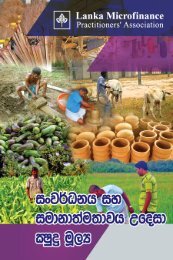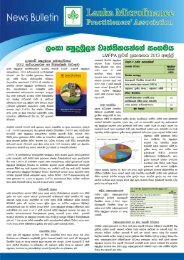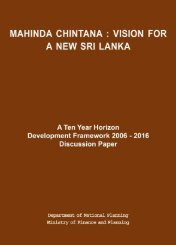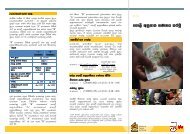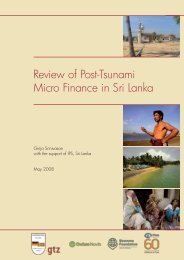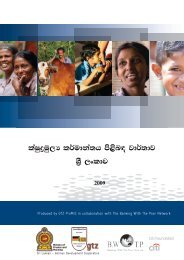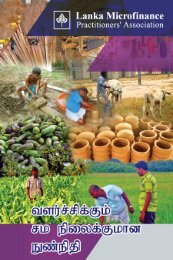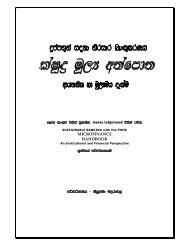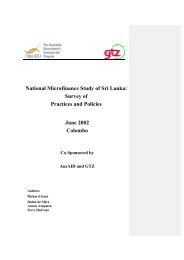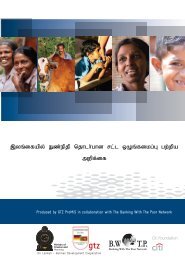Microfinance Industry Report SRI LANKA - Microfinance in Sri Lanka
Microfinance Industry Report SRI LANKA - Microfinance in Sri Lanka
Microfinance Industry Report SRI LANKA - Microfinance in Sri Lanka
Create successful ePaper yourself
Turn your PDF publications into a flip-book with our unique Google optimized e-Paper software.
Annex 3: Profile of <strong>Microf<strong>in</strong>ance</strong><br />
Institutional Types<br />
>> Regional Development Banks and other<br />
licensed specialized banks – There are 6 RDBs<br />
(Kandurata, Rajarata, Ruhuna, Sabaragamuwa,<br />
Uva and Wayamba) each cover<strong>in</strong>g a geographical<br />
region of the country. The Northern Prov<strong>in</strong>ce<br />
and part of the Eastern Prov<strong>in</strong>ce are not covered.<br />
Government owned, the RDBs cater to the higher<br />
end of the microf<strong>in</strong>ance market and the SME<br />
sector. Sanasa Development Bank is the only<br />
other licensed specialized bank with a focus on<br />
microf<strong>in</strong>ance. Owned by the Sanasa Thrift and<br />
Credit Co-operatives (TCCSs), it serves as the apex<br />
bank for the Sanasa system and also engages <strong>in</strong><br />
direct retail level activities.<br />
>> Co-operative Rural Banks (CRBs) and other cooperatives<br />
– There are over 1,600 CRBs owned<br />
by the Multi-Purpose Cooperative Societies. In<br />
addition, there are other co-operatives which<br />
engage <strong>in</strong> microf<strong>in</strong>ance, notably the Women’s<br />
Development Co-operatives. All these are member<br />
owned societies registered with, and supervised<br />
by, the Department of Co-operative Development.<br />
Despite hav<strong>in</strong>g a large deposit base (they are<br />
permitted to accept member deposits), their<br />
lend<strong>in</strong>g activity is relatively low (Rs. 32 Bn deposit<br />
base and correspond<strong>in</strong>g loan portfolio of Rs. 22 Bn<br />
<strong>in</strong> 2007). Profits earned by well-perform<strong>in</strong>g CBRs<br />
are used to subsidize the losses of their parent<br />
MPCS.<br />
>> Thrift and Credit Co-operative Societies (TCCSs/<br />
Sanasa societies) – The TCCSs are the oldest<br />
microf<strong>in</strong>ance providers <strong>in</strong> the country. They were<br />
re-organized <strong>in</strong>to a federation under the Sanasa<br />
banner dur<strong>in</strong>g the late 1970s. However, most<br />
TCCSs <strong>in</strong> the North rema<strong>in</strong> <strong>in</strong>dependent of the<br />
Sanasa movement and have their own federation.<br />
Both Sanasa and non-Sanasa TCCSs are registered<br />
with, and supervised by, the Department of<br />
Co-operative Development. The Sanasa TCCSs<br />
advance loans largely from mobilized sav<strong>in</strong>gs but<br />
also have access to credit facilities from the Sanasa<br />
Development Bank. The Sanasa TCCSs have shown<br />
stagnant or decl<strong>in</strong><strong>in</strong>g performance over the past<br />
5 years and a programme to strengthen and<br />
modernize the societies is currently underway.<br />
> > Samurdhi Bank Societies (SBSs) – Samurdhi Bank<br />
Societies (SBSs) were established <strong>in</strong> 1996 as part of<br />
the National Samurdhi Programme, a wide-rang<strong>in</strong>g<br />
governmental poverty alleviation programme<br />
target<strong>in</strong>g youth, women and the disadvantaged.<br />
The SBSs target the very low <strong>in</strong>come population<br />
(def<strong>in</strong>ed as households hav<strong>in</strong>g an <strong>in</strong>come of less<br />
than Rs. 1,500 a month). The SBSs are essentially<br />
self-supervised. The Central Bank has cited the<br />
risks of SBSs mobilis<strong>in</strong>g large volumes of sav<strong>in</strong>gs<br />
without proper regulation and supervision.<br />
The SBSs have outlets throughout the country,<br />
<strong>in</strong>clud<strong>in</strong>g the conflict affected Northern Prov<strong>in</strong>ce.<br />
However, heavy subsidiz<strong>in</strong>g by the government<br />
and political <strong>in</strong>terference <strong>in</strong> the Samurdhi system<br />
have resulted <strong>in</strong> wide-spread <strong>in</strong>efficiencies which<br />
cast doubts on their ability to be susta<strong>in</strong>able<br />
without government support.<br />
36 microf<strong>in</strong>ance <strong>in</strong>dustry report - <strong>SRI</strong> <strong>LANKA</strong>




